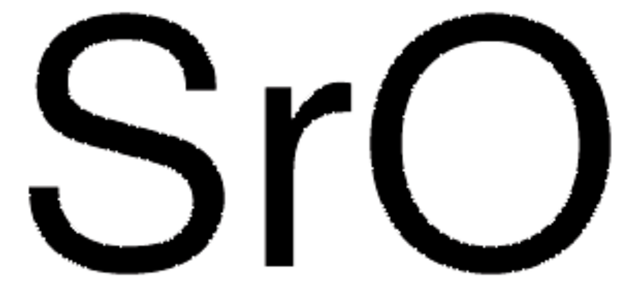517011
Strontium titanate
nanopowder, <100 nm particle size, 99% trace metals basis
Sinónimos:
Strontium metatitanate, Strontium titanium trioxide
About This Item
Productos recomendados
Quality Level
assay
99% trace metals basis
form
nanopowder
dielectric constant
300
reaction suitability
reagent type: catalyst
core: titanium
particle size
<100 nm
mp
2060 °C (lit.)
density
4.81 g/mL at 25 °C (lit.)
SMILES string
[Sr++].[O-][Ti]([O-])=O
InChI
1S/3O.Sr.Ti/q;2*-1;+2;
InChI key
VEALVRVVWBQVSL-UHFFFAOYSA-N
¿Está buscando productos similares? Visita Guía de comparación de productos
General description
Application
- Photoinduced electronic and ionic effects in strontium titanate: Focuses on the interaction of strontium titanate with ultraviolet radiation, investigating photoionic processes and photochromic effects, which are crucial for developing optoelectronic devices (M Siebenhofer et al., 2021).
- The emerging career of strontium titanates in photocatalytic applications: Reviews the role of strontium titanates in photocatalytic applications, particularly emphasizing their utility in environmental remediation processes (N Sharma, K Hernadi, 2022).
- Recent advances on carrier and exciton self-trapping in strontium titanate: Discusses the self-trapping of carriers and excitons in strontium titanate, providing insights into its electronic properties and implications for semiconductor technologies (ML Crespillo et al., 2019).
Storage Class
11 - Combustible Solids
wgk_germany
WGK 3
flash_point_f
Not applicable
flash_point_c
Not applicable
ppe
Eyeshields, Gloves, type N95 (US)
Certificados de análisis (COA)
Busque Certificados de análisis (COA) introduciendo el número de lote del producto. Los números de lote se encuentran en la etiqueta del producto después de las palabras «Lot» o «Batch»
¿Ya tiene este producto?
Encuentre la documentación para los productos que ha comprado recientemente en la Biblioteca de documentos.
Los clientes también vieron
Artículos
Synthesis, Properties, and Applications of Perovskite-Phase Metal Oxide Nanostructures
Nuestro equipo de científicos tiene experiencia en todas las áreas de investigación: Ciencias de la vida, Ciencia de los materiales, Síntesis química, Cromatografía, Analítica y muchas otras.
Póngase en contacto con el Servicio técnico





